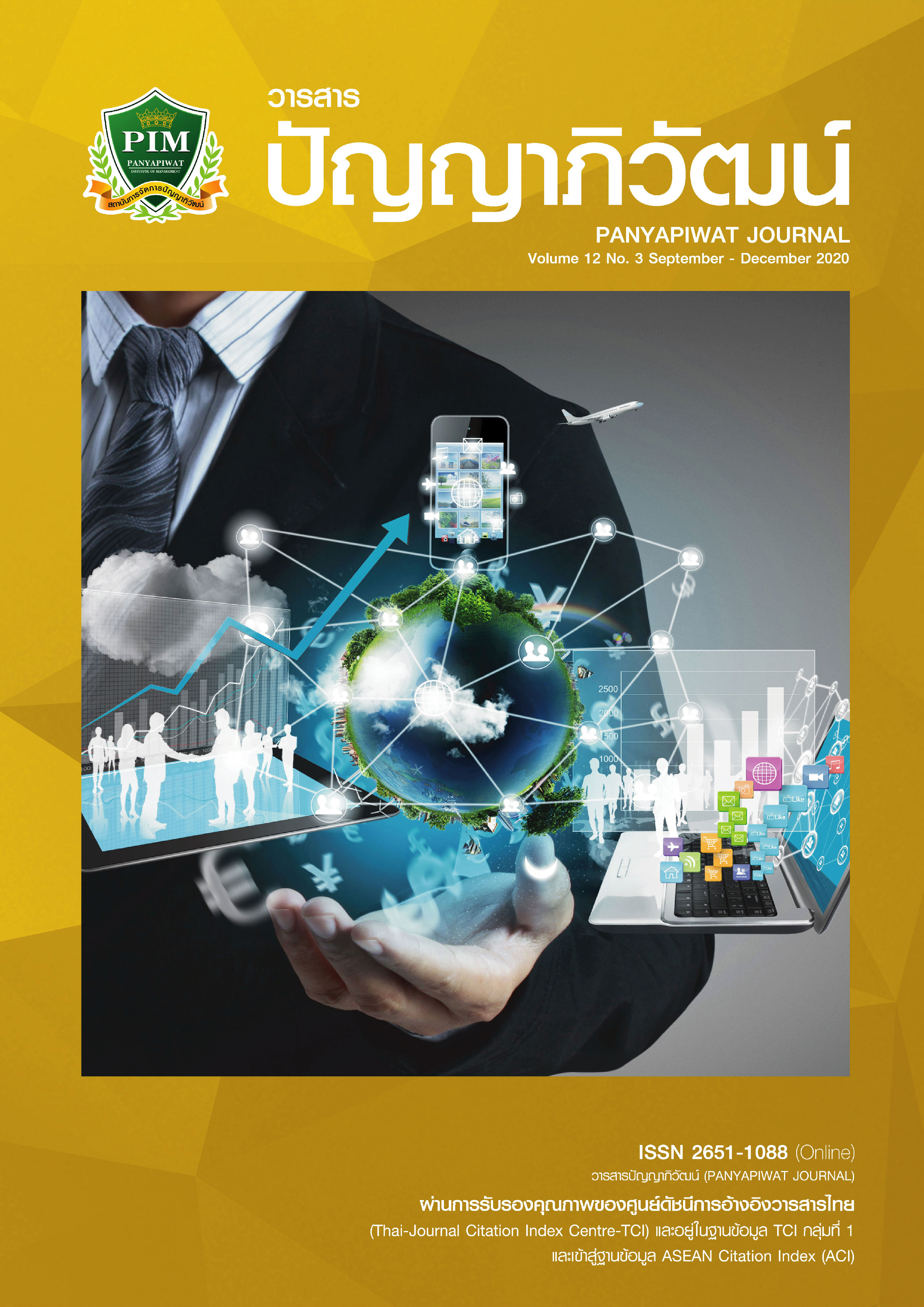สถานการณ์ปัจจุบันและแนวโน้มการพัฒนาการสอบวัดระดับทักษะ การใช้ภาษาญี่ปุ่นเชิงธุรกิจ (BJT) ในประเทศไทยตามความคิดเห็นของผู้เข้าสอบ
Main Article Content
บทคัดย่อ
งานวิจัยนี้ศึกษาเกี่ยวกับสถานการณ์ปัจจุบันของการสอบ BJT ในประเทศไทย รวมถึงแนวโน้มในการพัฒนาของการสอบ BJT ตามมุมมองของผู้เข้าสอบ โดยแบ่งกลุ่มตัวอย่างผู้เข้าสอบ BJT เป็น 2 กลุ่มคือ นักศึกษาชาวไทยที่ศึกษาภาษาญี่ปุ่น 61 คน และผู้ประกอบวิชาชีพด้านภาษาญี่ปุ่น 53 คน เครื่องมือที่ใช้ในการวิจัย ได้แก่ แบบสอบถามที่เป็นการสำรวจเชิงปริมาณ และใช้สถิติเพื่อการวิเคราะห์ข้อมูล
จากการสำรวจพบว่า กลุ่มที่เป็นนักศึกษาชาวไทยที่ศึกษาภาษาญี่ปุ่นมีความเห็นว่าการสอบ BJT นั้นเป็นการสอบที่มีความยาก และคิดว่าความสามารถด้านภาษาญี่ปุ่นของตนนั้นยังไม่เหมาะสมกับการสอบ BJT เท่าที่ควร ในทางกลับกันสำหรับกลุ่มผู้ประกอบวิชาชีพด้านภาษาญี่ปุ่นมีความเห็นว่าการสอบดังกล่าว เป็นการวัดทักษะความรู้ทางด้านภาษาญี่ปุ่นที่มีความเหมาะสมกับระดับความรู้ของตนเป็นอย่างดีเนื่องจากเป็นข้อสอบที่มีเนื้อหาเกี่ยวกับการทำงาน อย่างไรก็ตามผู้เข้าสอบที่เป็นกลุ่มผู้ประกอบวิชาชีพด้านภาษาญี่ปุ่นนั้น ยังไม่ตระหนักถึงคุณค่าและประโยชน์ของการสอบเท่าที่ควร จึงเป็นสาเหตุหลักที่ส่งผลให้จำนวนผู้เข้าสอบ BJT ยังไม่มากเท่าที่ควร ดังนั้นเพื่อให้การสอบ BJT เป็นที่แพร่หลายมากขึ้น ผู้วิจัยคิดว่าต้องสร้างการรับรู้ คุณค่าและประโยชน์ของการสอบ BJT แก่ผู้เกี่ยวข้องกับการสอบ BJT ให้มากขึ้น โดยแนะนำการสอบ BJT ให้เป็นส่วนหนึ่งในการคัดเลือกรับบุคลากรเข้าทำงานของบริษัทญี่ปุ่นในประเทศไทย พร้อมทั้งกำหนดคะแนนการสอบให้เป็นเกณฑ์อย่างเป็นรูปธรรม
Article Details
“ข้าพเจ้าและผู้เขียนร่วม (ถ้ามี) ขอรับรองว่า บทความที่เสนอมานี้ยังไม่เคยได้รับการตีพิมพ์และไม่ได้อยู่ระหว่างกระบวนการพิจารณาลงตีพิมพ์ในวารสารหรือแหล่งเผยแพร่อื่นใด ข้าพเจ้าและผู้เขียนร่วมยอมรับหลักเกณฑ์การพิจารณาต้นฉบับ ทั้งยินยอมให้กองบรรณาธิการมีสิทธิ์พิจารณาและตรวจแก้ต้นฉบับได้ตามที่เห็นสมควร พร้อมนี้ขอมอบลิขสิทธิ์บทความที่ได้รับการตีพิมพ์ให้แก่สถาบันการจัดการปัญญาภิวัฒน์หากมีการฟ้องร้องเรื่องการละเมิดลิขสิทธิ์เกี่ยวกับภาพ กราฟ ข้อความส่วนใดส่วนหนึ่งและ/หรือข้อคิดเห็นที่ปรากฏในบทความข้าพเจ้าและผู้เขียนร่วมยินยอมรับผิดชอบแต่เพียงฝ่ายเดียว”
เอกสารอ้างอิง
Ashihara, K. & Onozuka, W. (2014). Developing Business Japanese Can-do Statements as a Method to Evaluate Business Japanese Proficiency of High-Skilled Foreign Personnel: Measuring the Objectives of the Business Japanese Proficiency Test. Nihongo Kyouiku, 157, 1-16.
Deci, E. l. & Ryan, R. M. (2000). Intrinsic and extrinsic motivations: classic definitions and new directions. Contemporary Educational Psychology, 25, 54-67.
Japanese Language Proficiency Test. (n.d.). Historical data of candidate. Retrieved June 19, 2019 from https://www.jlpt.jp/statistics/archive.html
Japanese Language Proficiency Test. (n.d.). Advantages of JLPT. Retrieved July 26, 2019 from https://www.jlpt.jp/e/about/merit.html
Kaname, Y., Nakajima, S., Yoshizato S. & Hamanaka, M. (2009). Do Not Be Afraid of Statistics; What a Questionnaire for Analysis is: Introduction of Designing a Questionnaire for Factor Analysis. Japanese Education Practitioner Research Forum. Retrieved May 28, 2019, from http://www.nkg.or.jp/pdf/jissenhokoku/RT-5kaname.pdf
Kanome, Y. & Ohashi, M. (2018). Business Japanese Classes for Training Highly Skilled Foreign Professionals -Survey Results of Thai University Graduates and Japanese Enterprises Study. Journal of Tokyo International University, The Study of Humanities and Sociology,3, 25-35.
Kuwana, S., Onozawa, K. & Kitamura, N. (2010). Analysis of the list of question items of the part of
grammar for Japanese Language Proficiency Test. Journal of Japanese Language Education-The Japan Foundation, 6, 109-123.
Oshio, K., Akimoto, M., Takeda, A., Abe, Y., Takanashi, M., Yanagisawa, Y., Iwamoto, R. & Ishige, J. (2008).
In preparation for producing vocabulary list of the new Japanese Language Proficiency Test. Journal of Japanese Language Education-The Japan Foundation, 4, 71-86.
The Japan Kanji Aptitude Testing Foundation. (2017). Business Japanese Proficiency Test–Official mock test & Guidelines. Kyoto: The Japan Kanji Aptitude Testing Foundation.
The Japan Kanji Aptitude Testing Foundation. (n.d.). The data of candidate. Retrieved December 11, 2018, from https://www.kanken.or.jp/bjt/candidate/
The Japan Foundation. (2019). Survey Report on Japanese-Language Education Abroad 2018 (Preliminary report value). Tokyo: The Japan Foundation.
The Society for Teaching Japanese as a Foreign Language. (2018). Report on the Project of Research and Study Regarding Business Japanese Proficiency Test. Kyoto: The Japan Kanji Aptitude Testing Foundation.
Udagawa, Y., Li, M., Liu, L. & Li, Z. (2013). Reasons for the decline in number of JLPT applicants in Hong Kong - Results from the Questionnaire. Nihon Gakkan, 16, 233-246.


